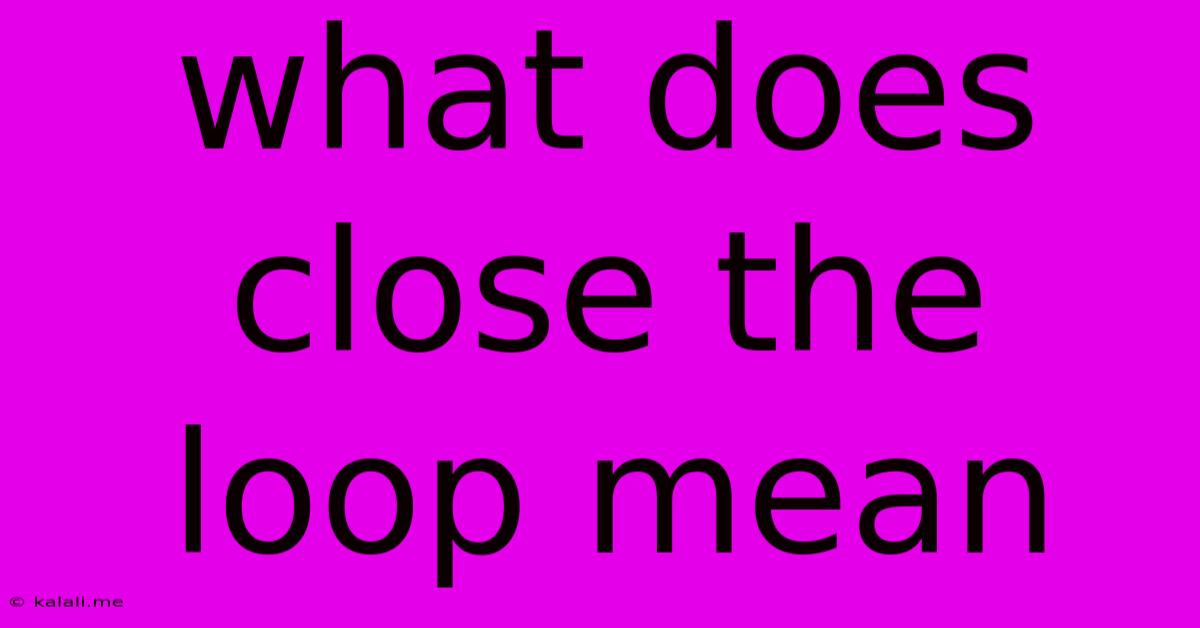What Does Close The Loop Mean
Kalali
Jun 01, 2025 · 4 min read

Table of Contents
What Does "Close the Loop" Mean? A Comprehensive Guide
Meta Description: Understanding "close the loop" goes beyond simple completion; it signifies a crucial feedback cycle for improvement and accountability. This article explores its meaning across various contexts, offering practical examples and highlighting its importance in business, project management, and customer service.
The phrase "close the loop" might sound like something from a sci-fi novel, but it's a common term used across numerous fields to describe a crucial process: completing a cycle and ensuring accountability. It's not just about finishing a task; it's about ensuring feedback is received and acted upon, creating a continuous improvement loop. This guide will delve into the meaning of "close the loop" and explore its implications in different contexts.
Understanding the Core Concept
At its heart, "closing the loop" means establishing a complete cycle. This cycle typically involves:
- Initiating an action: This could be anything from sending an email to launching a marketing campaign.
- Receiving feedback or results: Observing the outcome of the initiated action. This might involve analyzing sales data, receiving customer responses, or assessing project milestones.
- Taking action based on feedback: This is the crucial step. The feedback received is used to inform future actions, improve processes, or address issues.
- Communicating the resolution: This final step ensures transparency and accountability. It confirms that the feedback has been received, understood, and acted upon.
This iterative process is essential for continuous improvement and ensures that actions are not only completed but also lead to positive outcomes.
"Close the Loop" in Different Contexts
The application of "closing the loop" varies depending on the context. Here are a few examples:
1. Customer Service: When a customer reports a problem, closing the loop means resolving the issue and following up to ensure satisfaction. This might involve sending a confirmation email, offering a solution, or requesting feedback on the resolution. Excellent customer service hinges on effectively closing the loop on every customer interaction. This often includes proactive communication and follow-up, exceeding customer expectations and fostering loyalty.
2. Project Management: In project management, closing the loop involves ensuring that all tasks are completed, deadlines are met, and the project objectives are achieved. Regular progress reports, feedback sessions, and post-project reviews are key to successfully closing the loop in a project. This ensures that lessons learned are documented and applied to future projects, leading to increased efficiency and improved outcomes. Effective risk management and proactive problem-solving are also key aspects.
3. Business Processes: Closing the loop in business processes involves regularly reviewing and optimizing workflows. This could involve collecting data on key performance indicators (KPIs), identifying bottlenecks, and implementing changes to improve efficiency and productivity. Analyzing sales data, customer feedback, and market trends are all crucial steps in this continuous improvement cycle. The goal is to create streamlined, efficient systems that consistently deliver positive results.
4. Sales and Marketing: Closing the loop in sales and marketing means tracking the effectiveness of campaigns and using that data to refine future strategies. Analyzing conversion rates, customer acquisition costs, and return on investment (ROI) are vital steps in this process. Understanding which marketing channels are most effective and adjusting campaigns accordingly is crucial for maximizing results and optimizing resource allocation. This data-driven approach is essential for achieving sustainable growth.
The Importance of Closing the Loop
Closing the loop is not just a best practice; it's essential for several reasons:
- Improved Efficiency: Identifying and addressing problems early prevents them from escalating and causing larger issues down the line.
- Enhanced Customer Satisfaction: Responsiveness and follow-up demonstrate a commitment to customer needs, fostering loyalty and positive word-of-mouth referrals.
- Continuous Improvement: The feedback loop allows for constant optimization of processes and strategies.
- Increased Accountability: It ensures that all stakeholders are aware of the progress and outcomes of actions.
In conclusion, "closing the loop" is a powerful concept that applies across various domains. By understanding its principles and implementing them effectively, individuals and organizations can foster continuous improvement, enhance efficiency, and achieve better results. The key is to make it a consistent part of your workflow, regardless of the task or project at hand.
Latest Posts
Latest Posts
-
Why Does Cross Product Give Area
Jun 03, 2025
-
What Does Oso Mean In Spanish
Jun 03, 2025
-
Can You Put Stainless Steel In The Microwave
Jun 03, 2025
-
Ac Goes In And Out In Car
Jun 03, 2025
-
Can Kids Go To The Casino With Parents
Jun 03, 2025
Related Post
Thank you for visiting our website which covers about What Does Close The Loop Mean . We hope the information provided has been useful to you. Feel free to contact us if you have any questions or need further assistance. See you next time and don't miss to bookmark.